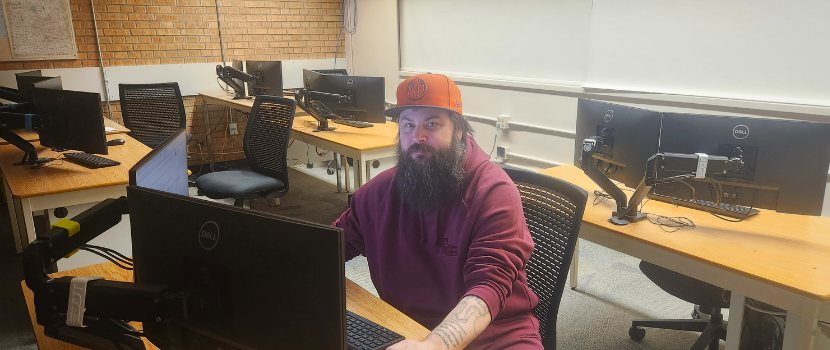REGINA — More than a decade after a workplace injury put a sudden halt on his career as a welder, Jeremy Still is making a major life transition to a career in engineering design and drafting technology. The Regina man, who describes himself as an active person by nature, was left unable to walk, stand or lift without difficulties. “It’s been a long haul,” he admits. “I can’t do what I wanted to be doing and that’s been hard. I’ve had to start again.”
The Worker’s Compensation Board (WCB) assessed Still and sent him for retraining for work that he could do while seated, which meant first obtaining Grade 12 equivalency.
“I had my Grade 10,” he says, “so I needed to upgrade before I could start any further education.”
The former welder completed that credential at Saskatchewan Polytechnic, then met with career counsellors at Regina campus to explore his options and get advice on what program might suit his skill set, interests and personality.
“I was a welder since high school,” reflects Still, “and it’s what I enjoyed doing. Leaving that behind was difficult. The career counsellors at Sask Polytech gave me some advice and the seemed like a good fit. In some ways it’s similar to welding as it requires puzzling things out, figuring out to make them work best.”
“Jeremy has been an excellent student even if he hasn’t always been sure of himself,” says Kaya Forest who, as program head, has been following his academic journey. “It’s taken a while to help him know that he is more than capable. He’s an extremely proactive person who asks a lot of up-front questions and that helps him find success as he works through his courses and projects.”
The program is normally completed over three years, but Still’s medical needs made part-time learning over a four-year period more realistic. “I have one semester to go and it’ll be great to be done,” he says. “My instructors have been really helpful and understanding about my medical appointments.”
Engineering Design and Drafting Technology includes three work terms. Still recently completed one term with Vale Industries in Indian Head, where he has been drafting and working on designs for industrial equipment used in the agriculture, and mining and quarrying industries. “The hardest change has been sitting all the time, but that’s what works for me,” he says. “Co-op has been a really good experience. They’ve been teaching me lots and they treat me like someone who works there. It’s been hard but good. It’s a steep learning curve.” He can graduate in April with one work term or chose to complete a second work term to receive the co-op education designation on his diploma.
Chris Dickson, who supervised Still at Vale Industries, says that like most new employees Still was inexperienced when he started: “Jeremy caught on very quickly, though. Because of his background, he understands the actual building of things on a welding floor. He’s got practical knowledge and looks at things differently. One of the things we came to appreciate about Jeremy is that he doesn’t overthink and overengineer things.”
Dickson, who shifted his career trajectory almost two decades ago from a financial sector background to a more hands-on path, joined Vale Industries and progressively navigated through almost every department. “I eventually took training in Inventor software and transitioned out of the shop to focus on engineering design, so I know what it’s like to go from the operational side of things to the planning and conceptual side.”
“I can tell you that it’s not always the university educated employees who offer the most insight,” adds Dickson. “Jeremy asks a million questions and he’s caught on quicker than guys we’ve hired with a master’s degree in engineering.”
Workplace injuries, like all of life’s unplanned events, can be challenging to recover from—especially when the work you’ve been doing is no longer possible. Still is an example of what resilience in the face of such a challenge looks like. “My new work is not what I’m used to,” he admits. “But it’s what I’m going to be doing now and I appreciate the training that’s helping me to get there.”
“Jeremy is goal oriented,” says Forest, “and he’s going to come to industry with a solid grounding in engineering design and drafting technology plus the advantage of a strong background in manufacturing. He’ll make a great employee for that reason—and on top of that he’s a really good person. We’ll miss having him in the program.”
Vale Industries made Still an offer of employment at the end of his co-op work term and hopes to bring him on board after graduation. Says Dickson, “Jeremy will be successful in this new part of his journey. He’s shown that he’s got what it takes.”
To learn more about Sask Polytech’s Engineering Design and Drafting Technology program or Co-operative Education opportunities, visit our website:
— Submitted by Sask Polytech Media Relations




